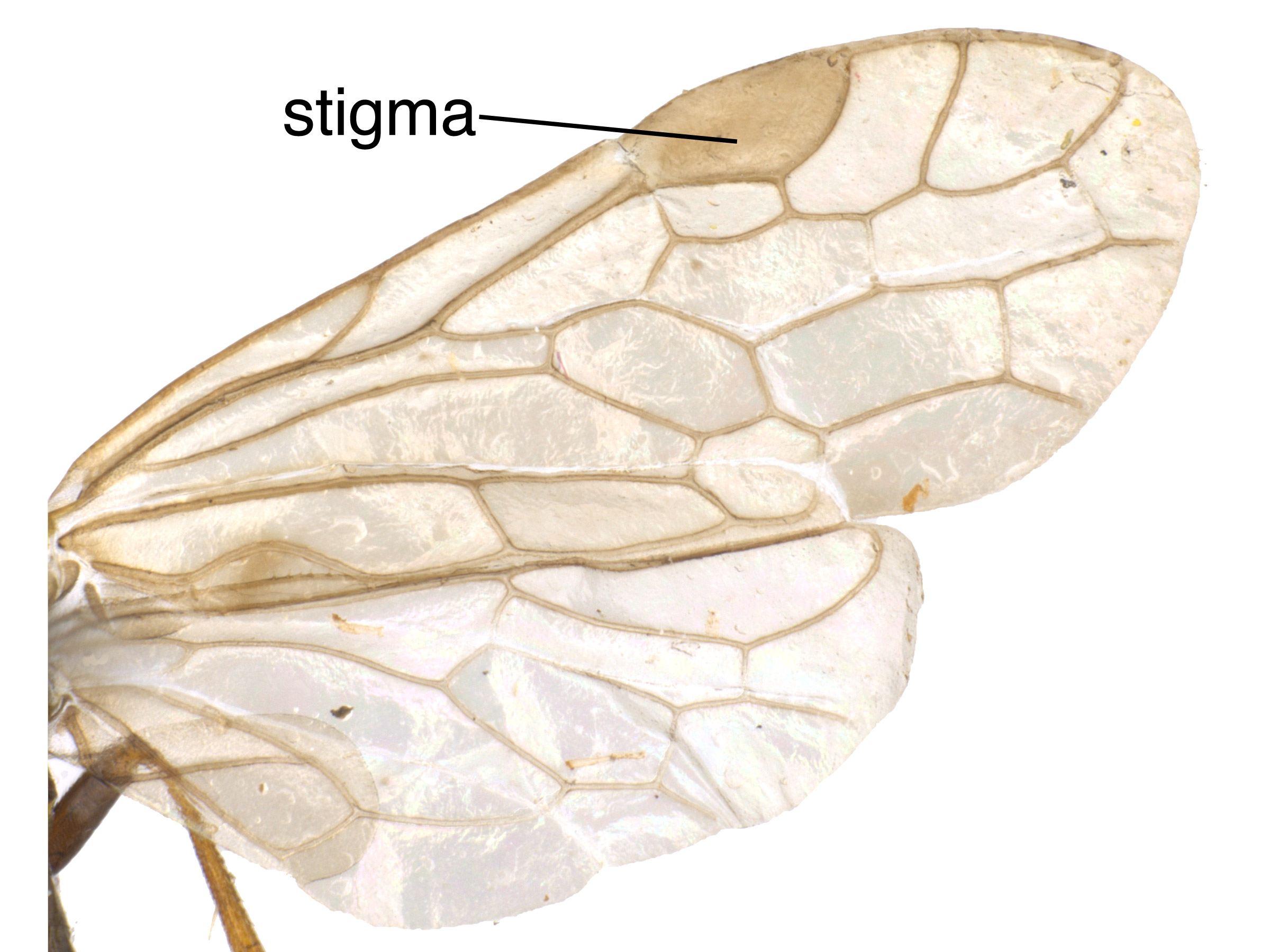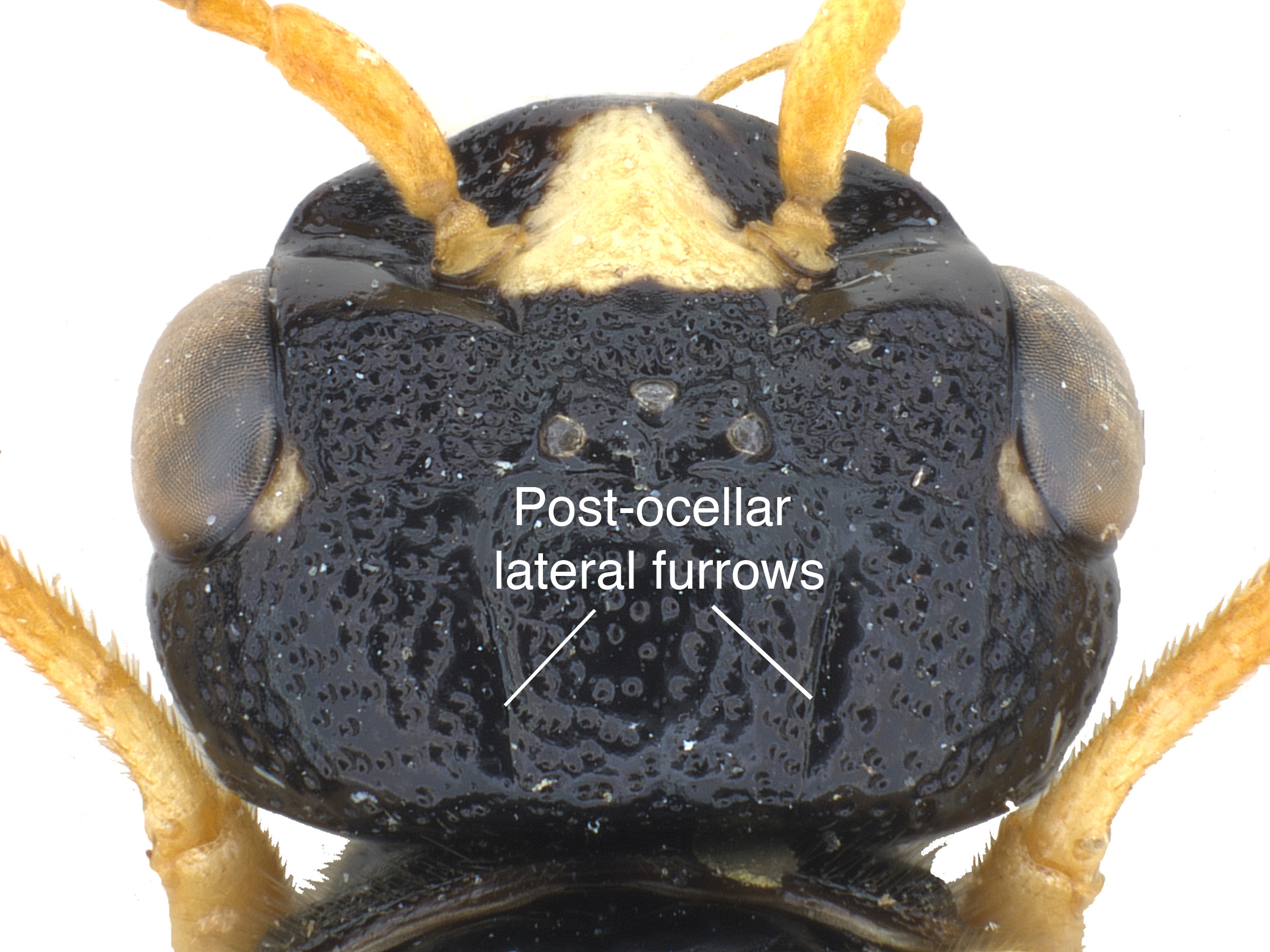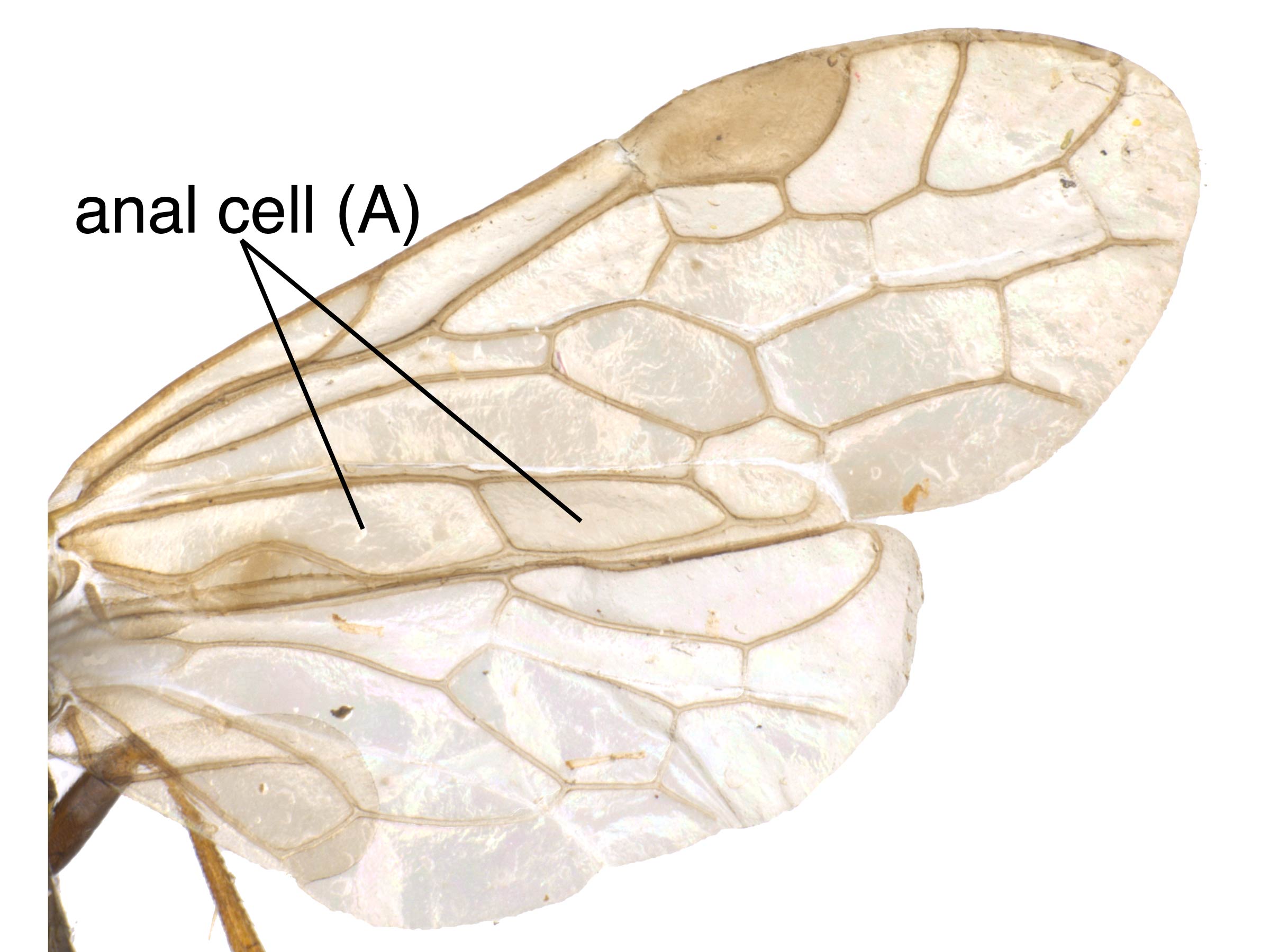Family: Tenthredinidae
Family common name: common sawflies
Subfamily: Nematinae
Tribe: Nematini
Genus: Hoplocampa Hartig, 1837
Subgenera: none
The Tenthredinidae are the most species-rich family and are found throughout the world, in all continents but Antarctica. They are known as the “common sawflies.” They can generally be recognized by a cylindrical body and long, segmented antennaeantenna:
the sensory organ emerging from the front of the head, usually between the compound eyes and above the clypeus; includes the flagellum, scape and pedicel
 . Otherwise, they come in a variety of colors, sizes, and forms (Goulet 1992Goulet 1992:
. Otherwise, they come in a variety of colors, sizes, and forms (Goulet 1992Goulet 1992:
Goulet H. 1992. The genera and subgenera of the sawflies of Canada and Alaska: Hymenoptera. Symphyta. The insects and arachnids of Canada. Part 20. Agriculture Canada Publication.).
Nematinae is the second-largest subfamily of Tenthredinidae with over 1,250 species (Prous et al. 2014Prous et al. 2014:
Prous M, Blank SM, Goulet H, Heibo E, Liston A, Malm T, Nyman T, Schmidt S, Smith DR, Varing;rdal H, Viitasaari M, Vikberg V, and Taeger A. 2014. The genera of Nematinae (Hymenoptera, Tenthredinidae). Journal of Hymenoptera Research 40: 1-69. " target="_blank">https://doi.org/10.3897/JHR.40.7442). They are most diverse in northern Eurasia and North America; only a few species occur in the Southern Hemisphere. Nematinae sawflies have a variety of feeding habits including external leaf feeding, leaf mining, and gall forming, and feed on a variety of hosts (Smith 2003bSmith 2003b:
Smith DR. 2003b. A Synopsis of the sawflies (Hymenoptera: Symphyta) of America south of the United States: Tenthredinidae (Nematinae, Heterarthrinae, Tenthredininae). Transactions of the American Entomological Society 129 (1): 1-45.).
The Nematinae have been subject to numerous revisions in recent years. As of 2021, there are no comprehensive keys to many of the North American species of Nematinae (Prous et al. 2014Prous et al. 2014:
Prous M, Blank SM, Goulet H, Heibo E, Liston A, Malm T, Nyman T, Schmidt S, Smith DR, Varing;rdal H, Viitasaari M, Vikberg V, and Taeger A. 2014. The genera of Nematinae (Hymenoptera, Tenthredinidae). Journal of Hymenoptera Research 40: 1-69. " target="_blank">https://doi.org/10.3897/JHR.40.7442). Because of changing taxonomy and extreme variability in morphology, identifying genera and species in the Nematinae may be more challenging than in other subfamilies of Tenthredindae. For this reason, knowing the host or behaviors of a specimen can be extremely helpful for identification within this subfamily.
Hoplocampa are about 7–9 mm in length, with variable colors. They feed on developing fruits of Rosaceae, including several agricultural crops such as apple, cherry, and pear, making them an economic pest (Ross 1943cRoss 1943c:
Ross HH. 1943c. The North American sawflies of the genus Hoplocampa (Hymenoptera: Tenthredinidae) Transactions of the American Entomological Society 69: 61-92.).
There are 45 described species worldwide. Twenty-two species occur in North America (Taeger et al. 2018Taeger et al. 2018:
Taeger A, Liston AD, Prous M, Groll EK, Gehroldt T, and Blank SM. 2018. ECatSymmdash;Electronic World Catalog of Symphyta (Insecta, Hymenoptera). Program version 5.0 (19 Dec 2018), data version 40 (23 Sep 2018). Senckenberg Deutsches Entomologisches Institut (SDEI), Muuml;ncheberg. https://sdei.de/ecatsym/ Accessed: 28 Jan 2020.).
A key to North American species is included in Ross 1943cRoss 1943c:
Ross HH. 1943c. The North American sawflies of the genus Hoplocampa (Hymenoptera: Tenthredinidae) Transactions of the American Entomological Society 69: 61-92..
Subfamily characters
 (Goulet 1992Goulet 1992:
(Goulet 1992Goulet 1992:Genus characters
 present (Goulet 1992Goulet 1992:
present (Goulet 1992Goulet 1992: and pedicelpedicel:
and pedicelpedicel: at least ¾ length of, or longer than, the first flagellomereflagellomere:
at least ¾ length of, or longer than, the first flagellomereflagellomere: (Goulet 1992Goulet 1992:
(Goulet 1992Goulet 1992: distinct and sharp (Prous et al. 2014Prous et al. 2014:
distinct and sharp (Prous et al. 2014Prous et al. 2014: vein 2m-cu meeting cellcell:
vein 2m-cu meeting cellcell: 2Rs above (Goulet 1992Goulet 1992:
2Rs above (Goulet 1992Goulet 1992: veins M and Rs+M relatively widely separated on veinvein:
veins M and Rs+M relatively widely separated on veinvein: R (Goulet 1992Goulet 1992:
R (Goulet 1992Goulet 1992: vein 2r-rs present (Goulet 1992Goulet 1992:
vein 2r-rs present (Goulet 1992Goulet 1992: vein 2A+3A meeting 1A; basalbasal:
vein 2A+3A meeting 1A; basalbasal: present (Prous et al. 2014Prous et al. 2014:
present (Prous et al. 2014Prous et al. 2014: narrow medially; membranous area posterior to tergitetergite:
narrow medially; membranous area posterior to tergitetergite: 1 wide (Goulet 1992Goulet 1992:
1 wide (Goulet 1992Goulet 1992:Hoplocampa may be confused with other genera in the subfamily Nematinae, particularly those with shorter antennaeantenna:
the sensory organ emerging from the front of the head, usually between the compound eyes and above the clypeus; includes the flagellum, scape and pedicel
 such as Adelomos or Caulocampus, but can be distinguished from most other genera by the wide space between fore wingfore wing:
such as Adelomos or Caulocampus, but can be distinguished from most other genera by the wide space between fore wingfore wing:
the anterior wing of each pair of wings; usually the largest wing of the pair
 veins M and Rs+M on veinvein:
veins M and Rs+M on veinvein:
a tube-like, often darkened, structure on the wings
 R, the presence of 2r-rs, the length of the scapescape:
R, the presence of 2r-rs, the length of the scapescape:
the first antennal segment
 and pedicelpedicel:
and pedicelpedicel:
the second antennal segment, between the scape and flagellum
 , and the location of fore wingfore wing:
, and the location of fore wingfore wing:
the anterior wing of each pair of wings; usually the largest wing of the pair
 vein 2m-cu (Goulet 1992Goulet 1992:
vein 2m-cu (Goulet 1992Goulet 1992:
Goulet H. 1992. The genera and subgenera of the sawflies of Canada and Alaska: Hymenoptera. Symphyta. The insects and arachnids of Canada. Part 20. Agriculture Canada Publication.).
Two sawflies are pests of plum in Europe. Hoplocampa minuta, the black plum sawfly, is a more significant economic pest than H. flava, the yellow plum sawfly, in most regions, appearing in greater abundance and inflicting greater damage. Both are multivoltinemultivoltine:
describing a life cycle with many generations per calendar year
(Tamošiūnas et al. 2014, Liston et al. 2019aListon et al. 2019a:
Liston AD, Prous M, and Varing;rdal H. 2019a. A review of West Palaearctic Hoplocampa species, focussing [sic] on Sweden (Hymenoptera, Tenthredinidae). Zootaxa 4615 (1): 1-45. https://doi.org/10.11646/zootaxa.4615.1.1). Because of the habit of feeding inside of the fruit, control methods are difficult to implement (Caruso and Cera 2004Caruso and Cera 2004:
Caruso S and Cera MC. 2004. Control strategies for plum sawflies ( Hoplocampa flava , Hoplocampa minuta ) in organic farming. Integrated plant protection in stone fruit IOBC/wprs Bulletin Vol. 27 (5): 105-107.).
Hoplocampa brevis is a pest of pear in southern regions of Europe, and occasionally feeds on apple as well (Liston et al. 2019aListon et al. 2019a:
Liston AD, Prous M, and Varing;rdal H. 2019a. A review of West Palaearctic Hoplocampa species, focussing [sic] on Sweden (Hymenoptera, Tenthredinidae). Zootaxa 4615 (1): 1-45. https://doi.org/10.11646/zootaxa.4615.1.1).
Hoplocampa cookei, a native species also known as the cherry fruit sawfly, has been recorded as a pest of cherry in California (Ross 1943cRoss 1943c:
Ross HH. 1943c. The North American sawflies of the genus Hoplocampa (Hymenoptera: Tenthredinidae) Transactions of the American Entomological Society 69: 61-92.).
The introduced H. testudinea, known as the apple sawfly, is a pest of apple fruit in Europe and North America (Liston et al. 2019aListon et al. 2019a:
Liston AD, Prous M, and Varing;rdal H. 2019a. A review of West Palaearctic Hoplocampa species, focussing [sic] on Sweden (Hymenoptera, Tenthredinidae). Zootaxa 4615 (1): 1-45. https://doi.org/10.11646/zootaxa.4615.1.1). Though the species is univoltineunivoltine:
describing an insect with a life cycle of one generation per year
, the fact that one larvalarva:
the immature stage of holometabolous insects
 can damage up to five or six apple fruits in its lifetime results in significant annual damage to fruit yields. Because of the protection the fruit provides, control methods for this pest are challenging (Pyenson 1943Pyenson 1943:
can damage up to five or six apple fruits in its lifetime results in significant annual damage to fruit yields. Because of the protection the fruit provides, control methods for this pest are challenging (Pyenson 1943Pyenson 1943:
Pyenson L. 1943. A destructive apple sawfly new to North America. Journal of Economic Entomology 36 (2): 218-221.).
In North America, Hoplocampa feeds on Malus (apple), Crataegus (hawthorn), Pyrus (pear), Prunus (cherry, plum), and Amelanchier (serviceberry) (Ross 1943cRoss 1943c:
Ross HH. 1943c. The North American sawflies of the genus Hoplocampa (Hymenoptera: Tenthredinidae) Transactions of the American Entomological Society 69: 61-92.).
Females oviposit into the calyx of a flower of the host. LarvaeLarva:
the immature stage of holometabolous insects
 bore into and feed on the immature fruit, often visiting several fruits during their development. Affected fruits often cease development and fall off the plant. At maturity, the larvaelarva:
bore into and feed on the immature fruit, often visiting several fruits during their development. Affected fruits often cease development and fall off the plant. At maturity, the larvaelarva:
the immature stage of holometabolous insects
 fall to the ground to overwinter and pupate (Ross 1943cRoss 1943c:
fall to the ground to overwinter and pupate (Ross 1943cRoss 1943c:
Ross HH. 1943c. The North American sawflies of the genus Hoplocampa (Hymenoptera: Tenthredinidae) Transactions of the American Entomological Society 69: 61-92.).
World: The genus is known from North America, North Africa, and throughout Europe and Asia (Liston et al. 2019aListon et al. 2019a:
Liston AD, Prous M, and Varing;rdal H. 2019a. A review of West Palaearctic Hoplocampa species, focussing [sic] on Sweden (Hymenoptera, Tenthredinidae). Zootaxa 4615 (1): 1-45. https://doi.org/10.11646/zootaxa.4615.1.1).
North America: Hoplocampa occurs throughout the United States and Canada (Ross 1943cRoss 1943c:
Ross HH. 1943c. The North American sawflies of the genus Hoplocampa (Hymenoptera: Tenthredinidae) Transactions of the American Entomological Society 69: 61-92.). Hoplocampa testudinea was introduced from Europe and first discovered on the East Coast in 1939 in New York (Pyenson 1943Pyenson 1943:
Pyenson L. 1943. A destructive apple sawfly new to North America. Journal of Economic Entomology 36 (2): 218-221.), and on the West Coast in 1940 in British Columbia (Downes and Andison 1942Downes and Andison 1942:
Downes W and Andison H. 1942. The apple sawfly Hoplocampa testudinea Klug. on Vancouver Island, British Columbia. Journal of the Entomological Society of British Columbia 39: 13-16.). It has since become established in the northeastern United States and southeastern Canada (GBIF).
Map data from: GBIF.org (29 October 2019) GBIF Occurrence Download Hoplocampa
Details about data used for maps can be found here.